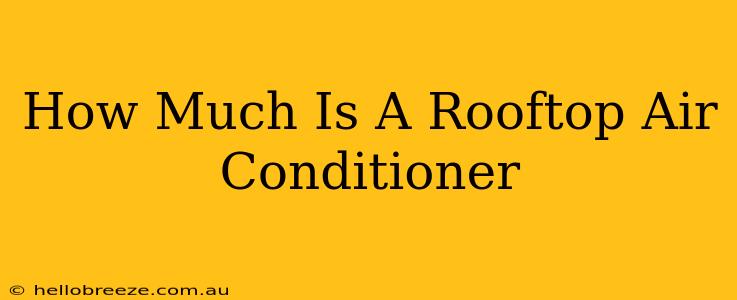Planning to install a rooftop air conditioner? Understanding the cost is crucial for budgeting your project. This guide breaks down the price of rooftop AC units, exploring factors influencing the final cost and helping you make informed decisions.
Factors Affecting Rooftop Air Conditioner Costs
The price of a rooftop air conditioner (often called a "RTU" or roof-top unit) isn't fixed. Several key factors significantly impact the total expense:
1. Unit Size and Capacity (Tons):
This is the most significant factor. Larger units with higher cooling capacities (measured in tons) cost more. A 3-ton unit will be more expensive than a 1.5-ton unit. Consider your space's cooling needs carefully – getting a unit too small or too large will lead to inefficiency and added expenses.
2. SEER Rating:
The Seasonal Energy Efficiency Ratio (SEER) measures the unit's energy efficiency. Higher SEER ratings mean lower energy bills over the unit's lifetime, but they come with a higher upfront cost. Investing in a higher SEER rated unit can save money in the long run.
3. Features and Options:
Several features can add to the cost, including:
- Heat pump capabilities: Units with heat pump functionality provide both heating and cooling, increasing the initial investment but potentially saving on heating costs.
- Variable speed compressors: These offer improved efficiency and comfort control, adding to the price.
- Smart technology: Wi-Fi connectivity and smart controls enhance convenience but increase the cost.
- Specific construction materials: Certain materials are more robust and durable, resulting in a higher price.
4. Installation Costs:
Installation is a significant part of the total expense. Factors influencing installation costs include:
- Roof access: Difficult roof access (steep roofs, multiple stories) increases labor costs.
- Electrical and refrigerant line runs: Longer runs increase labor and material expenses.
- Existing infrastructure: Modifications to existing ductwork or electrical systems will add to the cost.
- Permits and inspections: Local regulations may require permits and inspections, adding to the overall expense.
5. Brand and Model:
Different manufacturers offer various models with varying price points. Some brands are known for their premium quality and advanced features, leading to higher costs. Research different brands to compare features and prices.
Estimated Cost Ranges
While precise pricing requires a professional assessment, here's a general cost range to provide an initial understanding:
- Small units (1.5-2 tons): $3,000 - $7,000 (including installation)
- Medium units (3-5 tons): $5,000 - $12,000 (including installation)
- Large units (5+ tons): $10,000+ (including installation)
These are estimates only. Factors mentioned above can significantly impact the final cost.
Getting Accurate Pricing
To obtain accurate pricing, it's essential to:
- Contact multiple HVAC contractors: Get quotes from at least three reputable contractors.
- Clearly define your needs: Provide detailed information about your space's cooling requirements.
- Ask specific questions: Inquire about the unit's specifications, warranty, and installation process.
- Compare quotes carefully: Don't just focus on the lowest price; consider the value offered by each contractor.
Investing in a new rooftop air conditioner is a significant expense. By understanding the factors that influence cost and obtaining multiple quotes, you can make a well-informed decision that meets your budget and cooling needs. Remember that focusing solely on the initial price can be misleading; long-term energy savings from a more efficient unit should also be considered.

